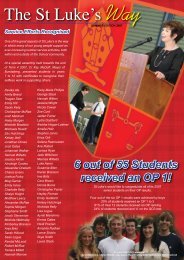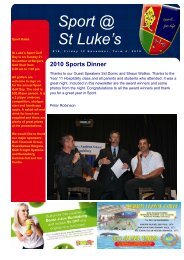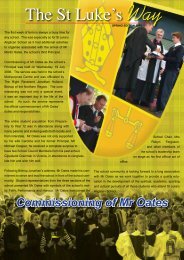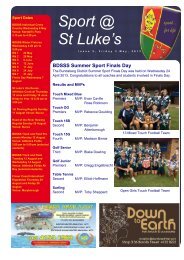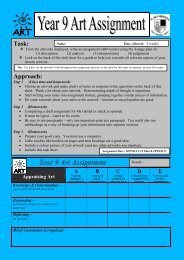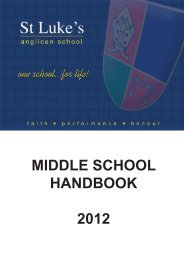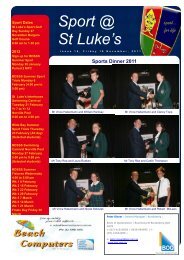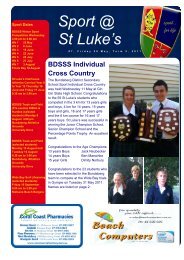year 10 science cloning â ert term 2 2013
year 10 science cloning â ert term 2 2013
year 10 science cloning â ert term 2 2013
Create successful ePaper yourself
Turn your PDF publications into a flip-book with our unique Google optimized e-Paper software.
YEAR <strong>10</strong> SCIENCE<br />
CLONING – ERT<br />
TERM 2 <strong>2013</strong><br />
SCIENCE UNDERSTANDING: Biological Chemical<br />
Physics<br />
Earth and Space<br />
Date Due: Week 16<br />
NAME<br />
SUBJECT<br />
TEACHER<br />
RESULTS<br />
Mr Babin<br />
Mr Cowan<br />
Mr Crook<br />
FORM CLASS<br />
DATE<br />
COMPLETED<br />
Understanding<br />
Skills<br />
<br />
Length: 500 - 600 words<br />
CONDITIONS<br />
I c<strong>ert</strong>ify that:<br />
This submission is my own work and work I have developed cooperatively with my<br />
partner/s. Any help received by other people has been acknowledged.<br />
I understand that:<br />
Plagiarism is a serious matter and that I may be penalised if this declaration is<br />
false.<br />
Work submitted after the due date will require a medical c<strong>ert</strong>ificate<br />
Application for extension must be sought two days before the due date.<br />
Student signature:<br />
Q:\Science\Senior School Science\Year <strong>10</strong>\Assessment <strong>2013</strong>\Genetics ERT - Term 2\Term 2 ERT - task sheet <strong>cloning</strong>.docx
Task<br />
You are to write an assignment based on the stimulus reading below and by answering the<br />
questions that follow. Your assignment must be written in essay style and not just be done<br />
in point form. Your assignment must also include a bibliography.<br />
Stimulus Reading<br />
by<br />
Jennifer Hayes-Klosteridis<br />
Ted McMasters sat alone in the overly warm waiting area of the Green Spring Valley shock trauma<br />
unit. It had been an hour since the state police marched into his law office on Calv<strong>ert</strong> Street to tell<br />
him his wife, Julie, and two-<strong>year</strong> old, Jason, had been in a serious car accident and were enroute<br />
via helicopter to the shock trauma unit. “It’s the best shock trauma unit on the coast,” he<br />
remembered hearing one of the officers say...like that mattered.<br />
Ted knew that Julie was on her way home from the babysitter’s when the accident happened.<br />
Ironically, she left work early because she wasn’t feeling well. They both hoped she was pregnant<br />
again. The state police told him she was stopped at a red light when an 18-wheel flatbed carrying<br />
a load of bricks slammed into the passenger side of her Audi A6 station wagon. She and Jason<br />
had been rushed to shock trauma within an hour of the accident. Both were in critical condition<br />
during the helicopter transfer and they were rushed immediately into surgery upon arrival.<br />
Ted stood shaking in the waiting room of the fourth floor surgical unit. He felt cold and wondered if<br />
it was the room temperature or the shock of the accident. Not knowing the status of Julie and<br />
Jason’s health was too painful for words. As he waited for news he reflected on his life.<br />
Ted and Julie wanted a child from the day they were married. They both came from large<br />
families and having children just seemed like the natural thing to do. It was such a long road<br />
trying to get pregnant with Jason ... ten <strong>year</strong>s and countless miscarriages had finally produced<br />
their son. Ted knew this baby would be their last chance for the “typical American” family. Of<br />
course he blamed himself. He should have frozen more sperm after his testicular cancer. Who<br />
knew that the radiation therapy would be so devastating to his ability to have children? It hadn’t<br />
been easy for them, but Jason was well worth the wait! He was a healthy, bright child with big<br />
brown eyes and a sprinkling of freckles across his nose. He loved to climb and always had<br />
scuffmarks on his knees. “I wonder if this new baby will be like Jason.” Ted wondered....<br />
“Mr. McMasters?” the sound of a doctor’s voice interrupted his musings. “I am Dr. Wilcox. I have<br />
been attending to your wife. She is in stable condition in the Intensive Care Unit. We managed to<br />
repair her punctured right lung and broken femur. Right now her prognosis is good. Ummm, sir, did<br />
you know that your wife was pregnant?”<br />
Q:\Science\Senior School Science\Year <strong>10</strong>\Assessment <strong>2013</strong>\Genetics ERT - Term 2\Term 2 ERT - task sheet <strong>cloning</strong>.docx
“She just had a pregnancy test yesterday. We are still waiting on results, why?”<br />
“Please sit down Mr. McMasters,” the doctor said gently, “I am so sorry. The stress from the<br />
accident caused your wife to haemorrhage. She lost the baby. Fortunately, the damage to her<br />
uterus is insignificant, so you will be able to have more children.”<br />
Stunned and devastated, Ted answered in a quavering voice: “I’m sterile.”<br />
“Oh, I am so sorry. Please forgive my assumption.”<br />
“Doctor, my baby boy was also in the accident with his mother. The paediatrician said they thought<br />
he had some internal bleeding, but they were taking him up to surgery and didn’t have any further<br />
information.”<br />
“There is no easy way to tell you this. I’m sorry. Jason’s injuries were quite substantial. His heart<br />
stopped beating while he was on the operating table. We were unable to revive him.”<br />
Ted McMasters slumped in his chair, silent tears streaming down his face. How could this be?<br />
How could Jason be gone? His big, brown-eyed baby boy, gone?<br />
“Mr. McMasters, I know this may not be the best time to mention this, but...”<br />
“Yes, my wife and I are organ donors, we would...”<br />
“Oh, I’m not suggesting organ donation. I am suggesting you contact a friend of mine, Dr. Bossilier.<br />
She is the director of Clonaid, the first human <strong>cloning</strong> company.”<br />
“What are you saying, doctor?”<br />
“I am saying that you and your wife could have Jason back, alive and healthy, by making a clone<br />
of him from his cells. He would be Jason’s identical twin, a chance for you to continue your family<br />
tree.”<br />
“Whaaaat? I’m not sure I understand what you’re saying.”<br />
“I’m saying that it may be possible for you to clone your son. I realize this all comes as quite a<br />
shock right now and you have to discuss your options with your wife. If you are interested, here’s<br />
my card.”<br />
Ted watched the doctor walk from the room and contemplated what he should do.<br />
Q:\Science\Senior School Science\Year <strong>10</strong>\Assessment <strong>2013</strong>\Genetics ERT - Term 2\Term 2 ERT - task sheet <strong>cloning</strong>.docx
Can you help Ted make his decision?<br />
Learning Questions:<br />
1. What is <strong>cloning</strong>? From a scientific standpoint, what procedures would be used to clone a<br />
human?<br />
2. Is <strong>cloning</strong> humans different procedurally from <strong>cloning</strong> animals? Are there any physiological<br />
risks to <strong>cloning</strong> humans? Are these risks different for animals? Why or why not?<br />
3. How does <strong>cloning</strong> differ from sexual reproduction?<br />
4. What role do meiosis and mitosis play in maintaining the integrity of the genetic code during<br />
<strong>cloning</strong>? Sexual reproduction?<br />
5. Will Jason II be “identical” to Jason I? Why or why not?<br />
6. What is the difference between a somatic cell and a sex cell?<br />
Information Resources:<br />
Books:<br />
Websites:<br />
<br />
<br />
<br />
<br />
<br />
Griffiths, J. F., Gelbart, W.M., Miller, J.H., Lewontin, R.C. (1999). Modern Genetic<br />
Analysis. New York: WH Freeman Publishers<br />
Human <strong>cloning</strong>:<br />
http://www.clonaid.com<br />
http://www.usnews.com<br />
http://www.web<strong>science</strong>news.com<br />
http://www.cnn.com<br />
http://www.nationalacademies.org<br />
http://www.rdi.gpo.or.th/NetZine/V3N43/<strong>cloning</strong>.htm<br />
http://www.ornl.gov/hgmis/elsi/<strong>cloning</strong>.html<br />
http://www.human<strong>cloning</strong>.org/<br />
Ethics of <strong>cloning</strong>:<br />
http://bioethics.georgetown.edu/nbac/<strong>cloning</strong>_letter.pdf<br />
http://www.bioethics.net<br />
http://www.gene-watch.org/<br />
Genetics links:<br />
http://www.biology.arizona.edu/<br />
http://www.nature.com/nsu/0<strong>10</strong>712/0<strong>10</strong>712-1.html<br />
http://library.thinkquest.org/3037/Lesson1.htm<br />
http://www.whfreeman.com/MGA<br />
http://www.kumc.edu/gec/<br />
In the news:<br />
http://www.pbs.org<br />
http://www.washingtonpost.com<br />
Q:\Science\Senior School Science\Year <strong>10</strong>\Assessment <strong>2013</strong>\Genetics ERT - Term 2\Term 2 ERT - task sheet <strong>cloning</strong>.docx
Skills Dimension Understanding dimension<br />
Science as a<br />
Human Endeavour<br />
Science Understanding<br />
Communicating<br />
Year <strong>10</strong> Science standard elaborations<br />
A B C D E<br />
The folio of student work has the following characteristics:<br />
U1 Clear description and<br />
comprehensive explanation<br />
of <strong>science</strong> knowledge<br />
Clear description and<br />
explanation of <strong>science</strong><br />
knowledge<br />
Description, definition and<br />
identification of <strong>science</strong><br />
knowledge<br />
Definition and statement of<br />
<strong>science</strong> knowledge<br />
Statement of isolated<br />
<strong>science</strong> knowledge<br />
U2 Critical analysis and<br />
application of <strong>science</strong><br />
knowledge to generate:<br />
solutions<br />
• reasoned explanations<br />
in a range of situations,<br />
including some that are<br />
complex<br />
Analysis and application of<br />
<strong>science</strong> knowledge to<br />
generate:<br />
solutions<br />
informed explanations<br />
in a range of situations,<br />
including some that are<br />
complex<br />
Application of <strong>science</strong><br />
knowledge to generate:<br />
solutions<br />
explanations<br />
in simple situations<br />
Application of <strong>science</strong><br />
knowledge to generate:<br />
partial solutions<br />
partial explanations<br />
Statements of isolated<br />
<strong>science</strong> facts<br />
U3 Critical analysis and<br />
description of the:<br />
development over time<br />
factors prompting the review<br />
of scientific models and<br />
theories<br />
Analysis and description of<br />
the:<br />
development over time<br />
factors prompting the review<br />
of scientific models and<br />
theories<br />
Description of the:<br />
development over time<br />
factors prompting the review<br />
of scientific models and<br />
theories<br />
Statements about the<br />
development over time of<br />
scientific models and<br />
theories<br />
Isolated statements about<br />
scientific models and<br />
theories<br />
S5 Coherent, concise and<br />
purposeful use of<br />
appropriate scientific<br />
language, conventions,<br />
representations and text<br />
types to communicate<br />
findings and ideas<br />
Clear and purposeful use of<br />
appropriate scientific<br />
language, conventions,<br />
representations and text<br />
types to communicate<br />
findings and ideas<br />
Use of appropriate scientific<br />
language, conventions,<br />
representations and text<br />
types to communicate<br />
findings and ideas<br />
Use of aspects of scientific<br />
language, conventions,<br />
representations and text<br />
types to communicate<br />
findings and ideas<br />
Use of everyday language<br />
to communicate findings<br />
and ideas<br />
Q:\Science\Senior School Science\Year <strong>10</strong>\Assessment <strong>2013</strong>\Genetics ERT - Term 2\Term 2 ERT - task sheet <strong>cloning</strong>.docx




